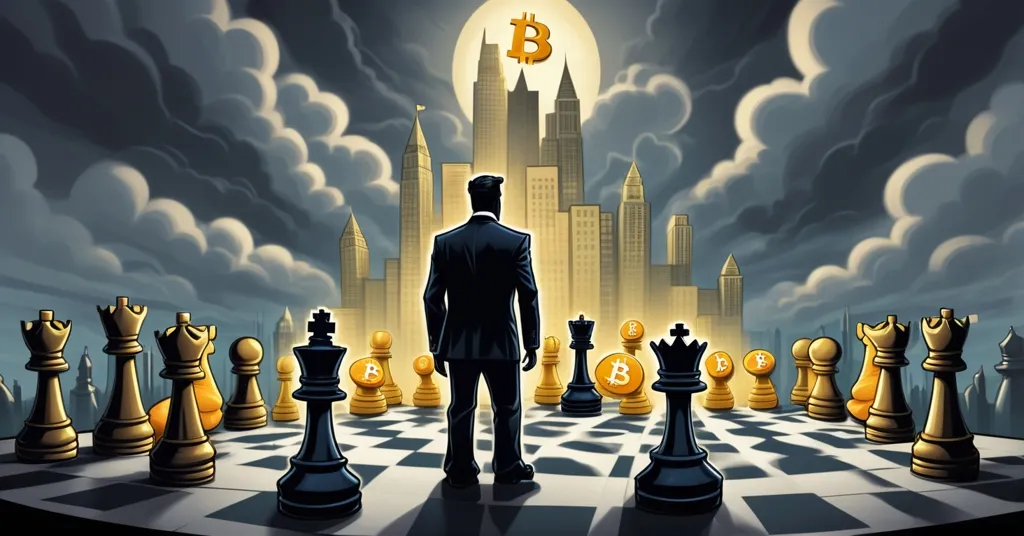Trump Picks Stephen Miran for Fed Board: Bitcoin and Crypto Markets Brace for Impact

Trump Nominates Stephen Miran to Fed Board: Bitcoin and Crypto Markets on Edge
President Donald Trump has ignited a firestorm in the financial realm by nominating Dr. Stephen Miran, Chairman of the Council of Economic Advisors, to an interim seat on the Federal Reserve’s Board of Governors. With a term lasting until January 31, 2026, this move replaces outgoing Governor Adriana Kugler and comes as Trump intensifies his crusade against Fed Chairman Jerome Powell for lower interest rates—a decision that could send shockwaves through Bitcoin and the broader crypto markets.
- Power Play: Trump appoints Stephen Miran to the Fed Board, filling Kugler’s vacancy until January 2026.
- Rate Cut Push: Trump clashes with Powell over high interest rates, with Miran potentially tipping the scales.
- Crypto Stakes: Fed policy shifts could fuel or flatten Bitcoin and altcoin markets.
Who Is Stephen Miran? Unpacking the New Fed Player
Stephen Miran isn’t just another suit in the economic arena. Holding a Ph.D. in Economics from Harvard, he’s a heavyweight with a track record that includes serving as an economic policy advisor in the Treasury Department during Trump’s first term. He also cut his teeth as a senior strategist at Hudson Bay Capital Management, a financial firm known for navigating complex markets. Currently, as Chairman of the Council of Economic Advisors, Miran has been a key voice in Trump’s second-term economic strategy. Trump didn’t mince words when announcing the pick, hyping him up with the kind of enthusiasm usually reserved for a championship boxer. For more on this nomination, check out the official announcement.
It is my Great Honor to announce that I have chosen Dr. Stephen Miran, current Chairman of the Council of Economic Advisors, to serve in the just vacated seat on the Federal Reserve Board until January 31, 2026… Stephen has a Ph.D. in Economics from Harvard University, and served with distinction in my First Administration. He has been with me from the beginning of my Second Term, and his expertise in the World of Economics is unparalleled — He will do an outstanding job. Congratulations Stephen!
But let’s cut through the fanfare. While Miran’s resume screams credibility, his exact stance on monetary policy remains a bit of a black box. Public statements from his past roles are sparse on specifics about interest rates or inflation control. Given his deep ties to Trump, though, it’s a safe bet he might lean toward policies that pump more money into the economy—often called expansionary policies—favoring growth over tightening the screws on spending. If true, that could align with Trump’s agenda, but it’s not a guaranteed slam dunk. For a deeper dive into his background, take a look at his profile. For now, we’re left reading tea leaves on how he’ll vote at the Fed’s next meetings.
Trump vs. Powell: A Brutal Rate Cut Battle
The backdrop of Miran’s nomination is a full-on slugfest between Trump and Jerome Powell over the direction of U.S. monetary policy. The Federal Reserve, for those new to the game, is the nation’s central bank, tasked with setting interest rates that dictate the cost of borrowing money. Think of it as the throttle on the economy—lower rates make loans cheaper, encouraging spending and investment, while higher rates slam the brakes to prevent runaway price increases, or inflation. Right now, rates sit at 4.25% to 4.50%, a level Trump has repeatedly slammed as too damn high, arguing it’s choking economic growth. He’s gone as far as calling Powell a “stubborn MORON” on social media—classic Trump, no filter. Read more about this ongoing tension in this detailed report.
Powell, on the other hand, is playing the cautious card, warning that external factors like Trump’s beloved tariffs—taxes on imported goods—could jack up prices for everyday stuff. Imagine imported sneakers or electronics suddenly costing 20% more at the store; that’s inflation creeping in, and it’s why Powell’s not rushing to slash rates. He’s been clear about the uncertainty, noting:
Higher tariffs have begun to show through more clearly to prices of some goods, but their overall effects on economic activity and inflation remain to be seen.
This isn’t just a policy spat; it’s a fundamental clash over what drives the economy. Trump wants cheap money now to juice growth, while Powell’s eyeing the long game, worried about reigniting inflation that could spiral out of control. Miran stepping into this ring, potentially as early as the September policy meeting, could shift the balance if he sides with Trump’s push for cuts. But here’s the kicker: meddling in Fed decisions breaks decades of tradition where presidents kept their hands off the central bank. Trump’s relentless jabs at Powell are a middle finger to that norm, and it’s raising eyebrows about the Fed’s independence.
The Economic Chessboard: Jobs, Politics, and a Sudden Exit
Zoom out, and the economic picture gets murkier. Recent data points to a weakening jobs market, with slower hiring and rising unemployment spooking markets. Trump’s seized on this, pointing to internal dissent within the Fed’s rate-setting committee as proof Powell’s losing the plot. “STRONG DISSENTS,” he’s tweeted, signaling he’s ready to exploit any cracks. Then there’s Adriana Kugler’s abrupt resignation, announced on August 1, 2025, and effective August 8, just months before her term ended. Was this a quiet protest against mounting political heat, or just bad timing? We’ll likely never know, but the optics scream opportunity for Trump to stack the deck. Learn more about her departure from the official statement.
Kugler’s exit—she’s returning to Georgetown University as a professor—hands Trump a chance to reshape the Fed, pending Senate Republican approval for Miran and possibly future picks. Rumors are swirling, with Bloomberg reporting that Governor Chris Waller is a frontrunner among Trump’s advisors to replace Powell as Chairman. Though Trump hinted on Newsmax that Powell might stay until his term winds down in about 7-8 months, he left the door open for a switch if markets “wouldn’t be disturbed.” Translation: expect more chess moves as Trump eyes control over the economic levers.
Crypto Markets: Will Fed Moves Spark a Bitcoin Boom or Bust?
Now for the million-dollar question every HODLer is mulling: could Trump’s Fed shake-up send Bitcoin to the moon or crater it into the dirt? Monetary policy isn’t some distant bureaucratic nonsense—it directly messes with risk assets like Bitcoin and altcoins, which thrive or dive based on how much cash is sloshing around the economy. Let’s break it down. When the Fed cuts rates, borrowing gets cheaper, and investors often chase higher returns in speculative markets—think Bitcoin, Ethereum, or even wildcards like Solana. History backs this up: post-2020, when rates dropped to near zero, Bitcoin rocketed from under $10,000 to over $60,000 in a year as liquidity flooded in. For insights into how these rate changes affect crypto, see this analysis.
If Miran throws his weight behind rate cuts, possibly as soon as September, we could see a similar rush. More cash in pockets might mean more bets on crypto, pushing Bitcoin prices up as a hedge against fiat devaluation. Altcoins could get an even wilder boost—Ethereum’s DeFi ecosystem, with its yield farming and lending protocols, or Solana’s NFT marketplaces often attract risk-hungry capital in loose money environments. But don’t pop the champagne yet. If Powell’s right and tariffs spike inflation, the Fed might hold rates steady or even hike them to cool prices. That tightens financial conditions, sapping appetite for volatile assets like crypto. A Bitcoin sell-off isn’t off the table if investors flee to safer bets like bonds. Check out community discussions on Miran’s potential influence on rates and Bitcoin in this Reddit thread.
Let’s get real with some numbers. After the Fed slashed rates in March 2020, Bitcoin saw a 30% monthly surge by late that year. Fast forward to today, analysts are split—some predict a modest 0.25% cut could drive 10-15% gains in crypto inflows, while others warn inflationary fears might trigger panic selling. For Bitcoin maximalists, a rate cut might feel like short-term candy, but the volatility tied to centralized whims is exactly why we champion decentralization. Altcoins, filling niches Bitcoin doesn’t touch—like smart contracts on Ethereum or interoperability on Polkadot—might see disproportionate swings, for better or worse. Recent market reactions to Miran’s nomination are covered in this market update.
Decentralization vs. Central Power Plays: A Double-Edged Sword
Dig deeper, and Miran’s nomination exposes a raw tension between centralized power grabs and the decentralized ethos Bitcoin was built on. Trump challenging the Fed’s status quo vibes with our love for disrupting legacy systems—after all, Bitcoin emerged from the ashes of 2008’s financial crisis as a middle finger to centralized mismanagement. Any crack in fiat trust could accelerate adoption of censorship-resistant, privacy-focused money. Hell, if Trump’s meddling speeds up the collapse of blind faith in central banks, isn’t that the ultimate “told you so” for crypto OGs? Curious about broader opinions on Miran’s potential impact on Bitcoin? Explore this Q&A thread.
But let’s not kid ourselves. Politicizing the Fed risks economic chaos—wild swings in policy could tank markets or spike inflation, the very instability Bitcoin aims to hedge against. If the Fed loses its independence and becomes a presidential puppet, trust in fiat might erode, sure, but so could overall economic stability. For Bitcoin to shine as a safe haven, it needs a backdrop of relative predictability, not a circus of volatility. Plus, short-term rate cuts might juice crypto prices, but they don’t address systemic issues—centralized control over money supply still looms large, clashing with our push for freedom and privacy. As much as we root for effective accelerationism to dismantle broken systems, this kind of meddling could backfire hard.
The Dark Side of Fed Interference
Here’s the ugly truth Trump fans might not want to hear: tampering with the Fed could be a disaster waiting to happen, even for crypto advocates. Historically, the Fed’s independence has been a buffer against short-sighted political agendas. If it turns into a tool for whoever’s in the White House, we’re looking at potential economic whiplash—policy flip-flops that could spook investors across all asset classes, Bitcoin included. Imagine rampant inflation from unchecked rate cuts, followed by panic hikes that crush growth. That’s not the steady decline of fiat we dream of; it’s a wrecking ball. For a closer look at Miran’s economic views and potential Fed impact, refer to this in-depth piece.
For Bitcoin purists, centralized meddling—whether it’s tariffs jacking up prices or Trump stacking the Fed—is just another reminder that top-down decisions can rock our decentralized vision. Sure, instability might drive some to crypto as a lifeboat, but if the broader economy tanks, even Bitcoin’s appeal as a store of value could take a hit. We’re all about disrupting the status quo, but chaos isn’t always the friend of adoption. This nomination, temporary as it is, might be a litmus test for how much political heat the financial system can take before it cracks—and whether crypto truly benefits from the fallout.
Key Questions and Takeaways on Fed Moves and Crypto
- What could Stephen Miran’s appointment mean for Federal Reserve policy?
Miran, aligned with Trump’s camp, might advocate for interest rate cuts as early as September, easing borrowing costs and potentially spurring economic activity. - Why is Trump hell-bent on lowering interest rates?
He sees high rates as a growth killer, pushing for cheaper loans to boost business and consumer spending without delay. - How do tariffs factor into the Fed’s inflation concerns?
Powell warns Trump’s tariffs could hike consumer prices—like imported goods costing more—fueling inflation that might deter rate cuts. - What does Adriana Kugler’s resignation signal for the Fed?
Her sudden exit opens the door for Trump to influence the Fed with loyalists like Miran, pending Senate Republican approval. - How might Fed policy shifts impact Bitcoin and crypto markets?
Rate cuts could flood liquidity into risk assets like Bitcoin, sparking rallies, while high rates or inflation fears might suppress crypto growth. - Could Fed instability strengthen Bitcoin’s case as a hedge?
Political meddling might erode fiat trust, driving some to Bitcoin as a safe haven, though broader economic chaos could muddle its appeal. - Do altcoins stand to gain or lose from Fed moves?
Altcoins like Ethereum, with DeFi and smart contracts, might see bigger short-term swings than Bitcoin if liquidity rises, but they’re also riskier in a downturn.
Ultimately, Miran’s nomination isn’t just a bureaucratic shuffle—it’s a flashpoint in the battle over America’s economic soul. As champions of Bitcoin and decentralization, we’re watching with a mix of optimism and wariness. Any dent in centralized control could pave the way for crypto’s rise, but the road might be paved with volatility that tests even the staunchest HODLers. Trump’s gambit could be a catalyst for financial freedom, or just another messy chapter of politics over principle. Either way, the blockchain doesn’t sleep, and neither should we as the Fed’s next moves unfold.



